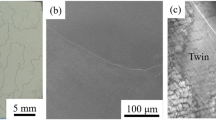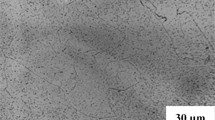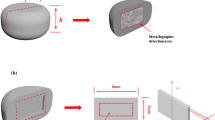Abstract
The development of equipment and technology makes it possible to manufacture a Ø2000 mm Alloy 706 disc 800 MN hydraulic press in China. Generally, high temperature or low strain rate is needed during the closed-die forging process to lower the requirement for press capacity; however, it will result in coarse unrecrystallized grains which are not beneficial for mechanical properties . In the investigation of hot deformation behavior by thermo-simulation compression tests in Alloy 706 , it is found that abnormal dynamic recrystallization (DRX) behavior occurs in a high temperature and low strain rate condition. Electron backscatter diffraction (EBSD ) investigation indicates that the fraction of twin boundaries in the abnormal microstructure is 80% lower than that in the normal microstructure , and apparent texture can be detected. Subscale disc forging experiments were carried out to investigate the effects of abnormal microstructure on mechanical properties of Alloy 706 . The microstructure evolution mechanism of abnormal DRX is validated and the influence on mechanical properties is discussed.
Access this chapter
Tax calculation will be finalised at checkout
Purchases are for personal use only
Similar content being viewed by others
References
Schilke PW et al (2001) Alloy 706 use, process optimization, and future directions for GE gas turbine rotor materials. In: Paper presented at the proceedings of the international symposium on superalloys 718, 625, 706 and various derivatives, Pittsburgh, 17–20 June 2001
Schilke PW et al (1994) Alloy 706 metallurgy and turbine wheel application. In: Paper presented at the proceedings of the international symposium on superalloys 718, 625, 706 and various derivatives, Pittsburgh, 26–29 June 1994
Johnson AM et al (1976) Properties and microstructure of a large forged superalloy turbine wheel. In: Paper presented at the proceedings of the third international symposium of superalloys: metallurgy and manufacture, Seven Springs, Pennsylvania.12–15 Sept 1976
Huang S, Wang L, Lian X et al (2014) Development of constitutive equation and processing maps for IN706 alloy. Acta Metall Sinica (English Letters). 27(2):198–204
Gourdet S, Montheillet F (2000) An experimental study of the recrystallization mechanism during hot deformation of aluminium. Mater Sci Eng, A 283(1):274–288
Wang Y, Shao WZ, Zhen L et al (2008) Microstructure evolution during dynamic recrystallization of hot deformed superalloy 718. Mater Sci Eng, A 486(1):321–332
Wang Y, Shao WZ, Zhen L et al (2008) Flow behavior and microstructures of superalloy 718 during high temperature deformation. Mater Sci Eng, A 497(1):479–486
McQueen HJ (2004) Development of dynamic recrystallization theory. Mater Sci Eng A 387:203–208
Jiang H, Dong J, Zhang M et al (2015) Hot deformation characteristics of Alloy 617B nickel-based superalloy: A study using processing map. J Alloy Compd 647:338–350
Jiang H, Dong J, Zhang M et al (2016) Evolution of twins and substructures during low strain rate hot deformation and contribution to dynamic recrystallization in alloy 617B. Mater Sci Eng A 649:369–381
Solberg JK, McQueen HJ, Ryum N et al (1989) Influence of ultra-high strains at elevated temperatures on the microstructure of aluminium. Part I Philos Mag A 60(4):447–471
Justinger H, Hirt G (2009) Estimation of grain size and grain orientation influence in microforming processes by Taylor factor considerations. J Mater Process Technol 209:2111–2121
Medeiros SC, Prasad YVRK, Frazier WG et al (2000) Microstructural modeling of metadynamic recrystallization in hot working of IN 718 superalloy. Mater Sci Eng A 293(1):198–207
Jafari M, Najafizadeh A (2009) Correlation between Zener-Hollomon parameter and necklace DRX during hot deformation of 316 stainless steel. Mater Sci Eng A 501(1):16–25
Zhou LX, Baker TN (1994) Effects of strain rate and temperature on deformation behaviour of IN 718 during high temperature deformation. Mater Sci Eng A 177(1–2):1–9
Raabe D, Sachtleber M, Zhao Z et al (2001) Micromechanical and macromechanical effects in grain scale polycrystal plasticity experimentation and simulation. Acta Mater 49(17):3433–3441
Wilcox BA, Clauer AH (1972) The role of grain size and shape in strengthening of dispersion hardened nickel alloys. Acta Metall 20(5):743–757
Moll JH, Maniar GN, Muzyka DR (1971) Heat treatment of 706 alloy for optimum 1200° F stress-rupture properties. Metall Mater Trans B 2(8):2153–2160
Detor AJ et al (2012) Grain boundary engineering alloy 706 for improved high temperature performance. In: Paper presented at the 12th international symposium on superalloys, Pennsylvania, 9–13 Sept 2012
Krueger DD, Antolovich SD, VanStone RH (1987) Effects of grain size and precipitate size on the fatigue crack growth behavior of alloy 718 at 427 & #xB0;C. Metall Trans A 18(8):1431–1449
Furrer D, Fecht H (1999) Ni-based superalloys for turbine discs. JOM 51(1):14–17
Alexandre F, Deyber S, Pineau A (2004) Modelling the optimum grain size on the low cycle fatigue life of a Ni based superalloy in the presence of two possible crack initiation sites. Scripta Mater 50(1):25–30
Lynch SP, Radtke TC, Wicks BJ et al (1994) Fatigue crack growth in nickel-based superalloy at 500–700 °C II: Direct-aged alloy 718. Fatigue Fract Eng Mater Struct 17(3):313–325
Miao J, Pollock TM, Jones JW (2009) Crystallographic fatigue crack initiation in nickel-based superalloy René 88DT at elevated temperature. Acta Mater 57(20):5964–5974
Acknowledgements
The authors appreciate the financial support from National Basic Research Program (863 Program) of China under Grant No.2012AA03A510. The authors also thank Ph.D Jiang He from University of Science and Technology Beijing for the help and advice in the DRX mechanism for abnormal microstructure.
Author information
Authors and Affiliations
Corresponding author
Editor information
Editors and Affiliations
Rights and permissions
Copyright information
© 2018 The Minerals, Metals & Materials Society
About this paper
Cite this paper
Huang, S., Zhang, B., Zhang, W., Zhao, G., Qi, Z. (2018). The Abnormal Dynamic Recrystallization Behavior of a Large Alloy 706 Disc. In: Ott, E., et al. Proceedings of the 9th International Symposium on Superalloy 718 & Derivatives: Energy, Aerospace, and Industrial Applications. The Minerals, Metals & Materials Series. Springer, Cham. https://doi.org/10.1007/978-3-319-89480-5_68
Download citation
DOI: https://doi.org/10.1007/978-3-319-89480-5_68
Published:
Publisher Name: Springer, Cham
Print ISBN: 978-3-319-89479-9
Online ISBN: 978-3-319-89480-5
eBook Packages: Chemistry and Materials ScienceChemistry and Material Science (R0)




